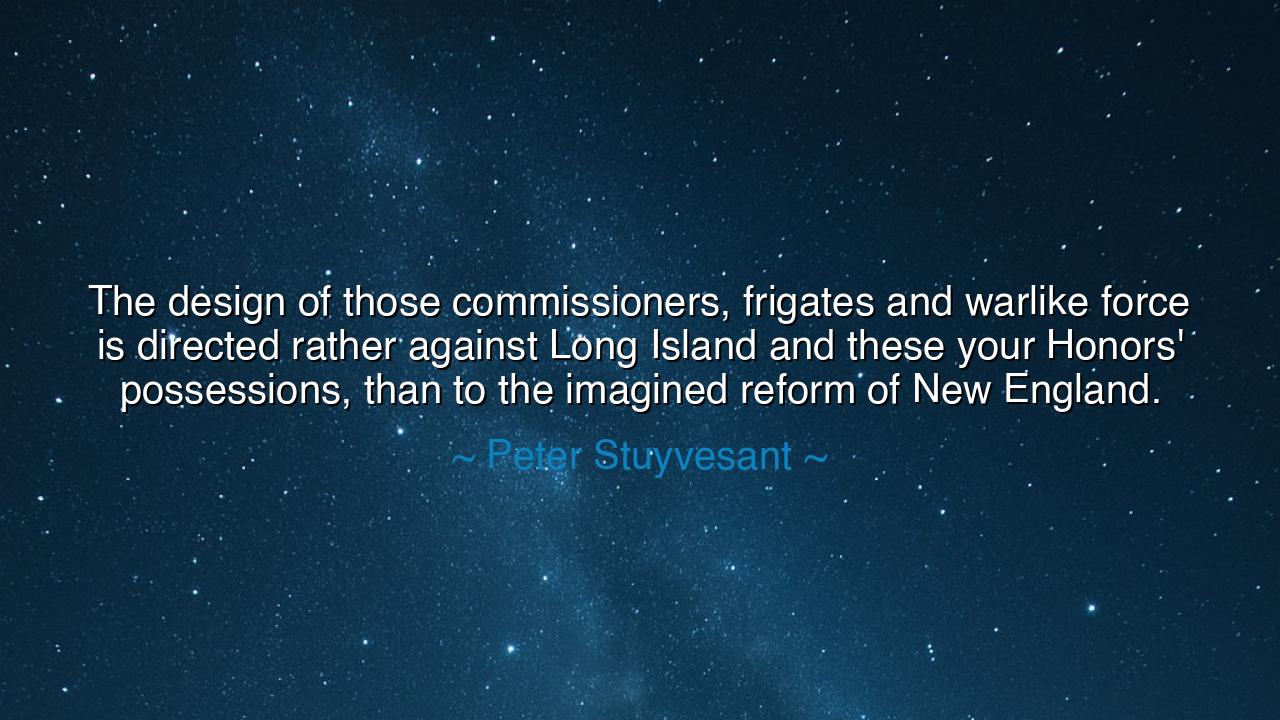
The design of those commissioners, frigates and warlike force is
The design of those commissioners, frigates and warlike force is directed rather against Long Island and these your Honors' possessions, than to the imagined reform of New England.






The words of Peter Stuyvesant — “The design of those commissioners, frigates and warlike force is directed rather against Long Island and these your Honors’ possessions, than to the imagined reform of New England.” — rise from a time of colonial turbulence, when empires clashed across oceans and new worlds were shaped by the ambitions of men. In this declaration, Stuyvesant, the last Dutch governor of New Netherland, speaks not only as a commander but as a guardian — one who sees through the illusions of diplomacy to the hidden designs of power. His tone is both defiant and discerning, for he recognizes that what is presented as noble “reform” is in truth a mask for conquest. Through these words, he exposes a timeless truth of human affairs: that power often cloaks its hunger in virtue, and that vigilance is the duty of all who wish to remain free.
In the year 1664, when Stuyvesant penned these words, the winds of imperial rivalry swept fiercely across the Atlantic. The English Crown, expanding its dominion, sent commissioners and warships to seize the Dutch territories in North America — lands that would one day bear the name New York. To the English, this mission was justified as a matter of reform, a quest to “bring order” and “unify” the colonies under one flag. But to Stuyvesant, who governed from New Amsterdam, the truth was unmistakable: the so-called mission of reform was a veil for aggression, and the true aim of the fleet was not the improvement of New England, but the subjugation of Dutch Long Island and the possessions of his people.
Stuyvesant’s words, though spoken in a moment of political crisis, resound with a philosophical depth that transcends his century. He warns us that whenever armies or institutions march under the banner of reform, we must ask: Who benefits from this reform? For history is filled with conquerors who clothed ambition in moral language — from emperors who claimed to bring “civilization” to the conquered, to powers who justified expansion as destiny or divine right. The wise must learn, as Stuyvesant did, to discern motive beneath rhetoric, and to see through the glittering words that hide the iron hand.
Yet there is tragedy in his defiance. Stuyvesant stood alone, facing the might of an empire he could not resist. Though brave, his pleas to his superiors in the Dutch West India Company fell on indifferent ears. He warned them that the English forces were not reformers but invaders, and that their purpose was to take what was not theirs. Still, the company hesitated; and soon, the English fleet appeared before the harbor of New Amsterdam. With no reinforcements and little powder, Stuyvesant was forced to surrender — not out of cowardice, but out of duty to his people, to spare them needless suffering. Thus, the city he had built with devotion passed quietly into enemy hands, and New Netherland became New York.
But his spirit of resistance was not in vain. For in the centuries that followed, his warning proved prophetic again and again. Nations have always faced the same test: to distinguish between true reform and conquest disguised as virtue. The lesson of Stuyvesant’s words is eternal — that justice and vigilance must walk hand in hand, and that even peaceful reforms must be examined lest they serve the designs of domination. The strength of a people lies not only in arms, but in the clarity with which they see the world’s deceit.
We may find a mirror of this wisdom in other moments of history. When Gandhi faced the British Empire, he too saw through the rhetoric of “civilizing mission” and exposed it as a mechanism of control. Like Stuyvesant, he answered not with hatred, but with conviction — proving that truth, once spoken with courage, endures beyond defeat. For both men understood that moral clarity is greater than force, and that those who defend what is right, even when they lose, leave behind a strength that outlives empires.
Thus, the teaching of Peter Stuyvesant is not only for rulers, but for all who would keep their integrity in an age of manipulation. Be wary of noble-sounding causes that conceal greed; question power that claims to act for your good while serving its own. And above all, defend your truth, even when surrounded by greater powers. For though New Amsterdam fell, its governor’s words still rise like a beacon across time — reminding us that the first defense of freedom is the ability to see clearly, and that to surrender that vision is to open the gate to conquest.






AAdministratorAdministrator
Welcome, honored guests. Please leave a comment, we will respond soon